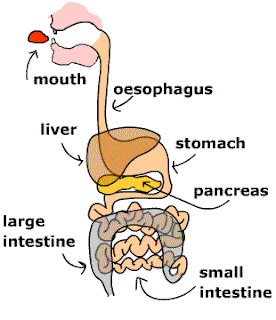THE DIGESTIVE SYSTEM
⇛ The digestive system has a vital role in the
function of nutrition.
⇛ The digestive system is the responsible for break
down the food we eat into smaller substances (nutrients) that our body can be use, and to expel the waste food out of the body.
 |
| THE DIGESTIVE SYSTEM |
THE DIGESTIVE PROCESS:
In the digestive process there are three stages:
 ↠The digestion: Digestion is the process that happens to food in the digestive tract to transform into nutrients. There are two types of digestion.
↠The digestion: Digestion is the process that happens to food in the digestive tract to transform into nutrients. There are two types of digestion.
Mechanical
digestion: When we chew and grind, the food in the mouth breaks into smaller
pieces.
Chemical digestion: It is the action of the enzymes, gastric juices... to break down more the food. It begins in the mouth with the saliva and after in the stomach and intestines.
↠The absorption: Absorption is when the nutrients are absorbed in the villi in the small intestine and pass to the blood.
↠The excretion: Excretion is the last step of digestion and consist in eliminate the food that the body doesn,t need.
PARTS OF THE DIGESTIVE SYSTEM:
The digestive system is a long tube that starts at the mouth and ends at the annus. The stomach, large intestine and small intestine process the food we eat. Other organs outside the digestive tract also participate in digestion. For example, the salivary glands, tongue, pancreas and liver are essential for digestion.
The first step is in the mouth. The teeth grind the food and with the tongue mixes it with the saliva making the bolus. The tongue push the bolus toward the back of the throat to the pharynx and then pass to the esophagus.
The bolus travels down through the esophagus to the stomach.
In the stomach the bolus mixes with enzimes and gastric juices and continue the process of breaking the food. The bolus transforms in a paste called chyme.
The chyme moves to the small intestine. In the small intestine the chyme becomes chyle for the action of other juices that secret the small intestine, the pancreas and the liver.
The food finish the process of digestion. In this moment begins the process of absorption in the small intestine.
The food that has not been absorbed goes to the large intestine. The water is absorbed and the rests are transformed into faeces to be eliminated through the annus.
FUN FACTS:
⇛We eat about 500kg of food per year.
⇛The empty stomach has a small volume but can expand to have 1.5 litres of food.
⇛Some animals haven't stomach (seahorses, platypuses...) and others animals like giraffes, cows and deers have stomachs with some compartments.
⇛The esophagus is 25cm long.
⇛The lenght of the small intestine is 7 meters.
⇛The large intestine is 1,5 meters long.
⇛The esophagus is 25cm long.
⇛The lenght of the small intestine is 7 meters.
⇛The large intestine is 1,5 meters long.


No hay comentarios:
Publicar un comentario